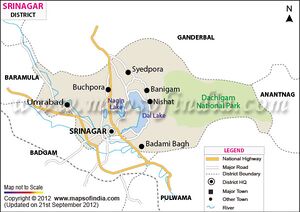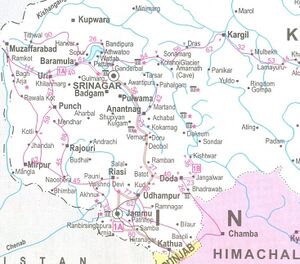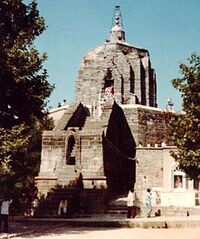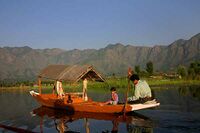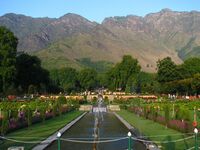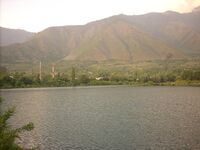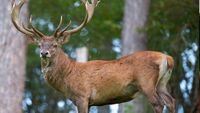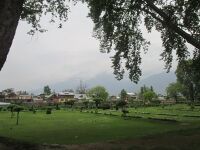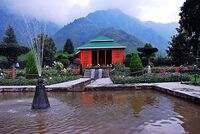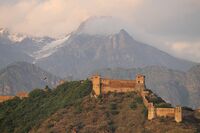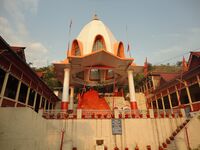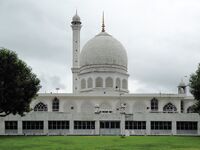Srinagar
| Author:Laxman Burdak, IFS (R) |
Srinagar (श्रीनगर) is the summer capital of Jammu and Kashmir. The city is known for its natural environment, gardens, waterfronts and houseboats. It is also known for traditional Kashmiri handicrafts like Kashmir shawls and also dried fruits.
Contents
- 1 Variants of name
- 2 Location
- 3 Origin of name
- 4 History
- 5 Jat History
- 6 Tehsils & Villages in Srinagar District
- 7 Places of Interest
- 8 Shankaracharya Temple
- 9 Nishat Bagh
- 10 Shalimar Bagh, Srinagar
- 11 Chashme Shahi
- 12 Hari Parbat
- 13 शंकराचार्य मंदिर
- 14 श्रीनगर
- 15 श्रीनगर परिचय
- 16 श्रीनगर के मुख्य आकर्षण
- 17 शिरिनेत = सिरनेत
- 18 काश्यप लोग
- 19 Kasmir visit of Xuanzang in 631 AD
- 20 References
Variants of name
- Shrinagara श्रीनगर (2) = Jammu and Kashmir (AS, p.919)
- Shirineta शिरिनेत = Siraneta सिरनेत = Srinagar (श्रीनगर) (AS, p.900)
- Siraneta सिरनेत = Shiraneta शिरनेत = Srinagar (श्रीनगर)(AS, p.966)
- Pandrethan
- Puranadhisthana
- Srinagar (श्रीनगर)
- Srinagara
- Srinagari
- Pravarasenapura = Named after Sri Pravarsena (or Paro Sen) ruled from Kashmir to Gandhara with his capital at Pravarsenapura, modern Srinagar. He was son of Toramana.[1]
Location
It lies in the Kashmir Valley, on the banks of the Jhelum River, a tributary of the Indus.
Origin of name
Kalhana's Rajatarangini, mentions the Sanskrit name shri-nagara which has been interpreted as Sūrya-nagar, meaning "City of the Surya" (trans) "City of Sun". [2]
Kalhana[3] notes in Rajatarangini that Maurya Emperor Ashoka built the city of Srinagari in the 3rd century BC and also built many stupas in Kashmir on the rocky banks of the Vitasta (Jhelum) at Shushkaletra. On the extremity of Dharmaranya he built a chaitya so high that its top could not be seen. It was he who built Srinagara, which contained no less than ninety-six lacs of beautiful houses.
History
The city is said to have been named by the King Pravarasena II over 2,000 years ago, who is said to have named it Parvarasenpur.[4]
Rajatarangini[5] tells us that Pravarasena subdued many kings, and his fame spread far and wide like that of Agastya muni, and his army reached the sea in their march of conquest ; and the perspiration of his elephants made the waters of the Ganges look like the confluence of that river -with the Yamuna. He defeated the people of Saurashtra and upset the administration of the kingdom. His mind was so bent on the acquisition of fame, that he was indifferent to all earthly things, having no attachment towards any object. Pratāpasila otherwise called Shiladitya, son of Vikramaditya, was expelled by his enemies from his father's territory. Pravarasena reinstated him, and brought back the throne of the kings of Kashmira from the capital of Vikramaditya. Pratapasila for seven times refused to acknowledge the supremacy of the king of Kashmira, and the latter had to subdue him seven times. On the eighth occasion, Pravarasena called Pratapasila a brute and intended to take his life. The latter, however, saved himself by self-humiliation, and suggested that if he was a beast, his life was too insignificant to be destroyed. Pratipasila also amused the Kashmirian king by dancing before his court like a peacock, and imitating tho voice of that bird;. whereupon Pravarasena not only took him under his protection, but also bestowed riches on him. After conquering the world, he lived in the city raised by his grand-father, but felt a desire to found a city in his own name. In the village of Sharitaka Pravarasena proposed to build a city. But before he did so, he wished to set up Pravareshvara Shiva.
Kalhana[6] notes in Rajatarangini that Maurya Emperor Ashoka built the city of Srinagari in the 3rd century BC and also built many stupas in Kashmir on the rocky banks of the Vitasta (Jhelum) at Shushkaletra. On the extremity of Dharmaranya he built a chaitya so high that its top could not be seen. It was he who built Srinagara, which contained no less than ninety-six lacs of beautiful houses. He pulled down the dilapidated wall of the compound of the temple of Srivijayesha and built a new stone wall in its stead. He also caused to be erected two palaces near the courtyard of that god, and named them Ashoka and Isvra.
The city was then a part of the Maurya Empire, one of the largest empires of the Indian subcontinent.[7] Ashoka introduced Buddhism to the Kashmir valley, and the adjoining regions around the city became a centre of Buddhism.[8]
In the 1st century, the region was under the control of Kushans, based out of modern Pakistan and Afghanistan. Several rulers of this dynasty strengthened the Buddhist tradition.[9]
Vikramaditya (of Ujjain) and his successors probably ruled the regions just before the city fell to the control of the Huns - a nomadic tribe from central Asia in the 6th century, and Mihirkula was the most dreaded ruler of the city and the valley.[10]
Kalhana[11] tells us that Durlabhavardhana had many children. An astrologer predicted that Mahlana, one of the sons of the king, would not live long, so the boy raised a god Mahlanasvami. The king bestowed a village named Chandra near the hill Vishokakota, upon the Brahmanas. He also set up a Hari named Durlabhasvami at Shrinagara.
Srinagar became the capital of Kashmir around 960 CE, under the rule of the Hindu Shahis of Kabul.[12]
The independent Hindu and the Buddhist rule of Srinagar lasted until the 14th century when the Kashmir valley, including the city, came under the control of the several Muslim rulers, including the Mughals. It was also the capital during the reign of Yusuf Shah Chak, an Independent Kashmiri ruler who was tricked by Akbar when Akbar failed to conquer Kashmir by force. Yusuf Shah Chak remains buried in Bihar. Akbar established Mughal rule in Srinagar and Kashmir valley.[13]
With the disintegration of the Mughal empire after the death of Aurangzeb in 1707, infiltrations to the valley from the Pashtun tribes increased, and the Durrani Empire ruled the city for several decades.
Maharaja Ranjit Singh of Punjab province annexed a major part of the Kashmir Valley, including Srinagar, to his kingdom in the year 1814 and the city came under the influence of the Jat Sikhs.
In 1846, the Treaty of Lahore was signed between the Sikh rulers and the British in Lahore. The treaty inter alia provided British de facto suzerainty over the Kashmir Valley and installed Gulab Singh as an independent and sovereign ruler of the region.
Jat History
Shankar Lal Barala was in CRPF jawan, a resident of Tejpura village in Shahpura area near Jaipur, was martyred on 24.7.2018 in a terror attack in Batamaloo locality of Srinagar, Jammu and Kashmir.
Ramesh Chaudhary (रमेश चौधरी) (27), BSF jawan, from Nagani, Reodar tahsil, Sirohi, Rajasthan, posted in Jammu and Kashmir, got martyrdom of militancy on 10.9.2016. Ramesh Kumar Chaudhary was a Gunner Operator who had died at the Military Hospital in Srinagar on September 10,2016. His body was brought to his ancestral village of Nagani in Sirohi where his family members conducted the cremation ceremony in the presence of his army unit and another unit from Mount Abu.
Tehsils & Villages in Srinagar District
Tehsils in Srinagar District: 1. Srinagar North Srinagar, 2. Srinagar South
List of towns and Villages in Srinagar North Tehsil of Srinagar district:
Towns: 1 Srinagar, 2 Badami Bagh, 3 Khonmoh,
Villages: 1 Dara, 2 Faqir Gujri, 3 Gagarzoo, 4 Inder Hama, 5 Mulanar, 6 Sangam, 7 Takan Wari Pora, 8 Takya Sangi Reshi,
List of all towns and Villages in Srinagar South Tehsil of Srinagar district
Towns: 1 Srinagar, 2 Lasjan, 3 Now Gam,
Villages 1 Abdullah Pora, 2 Kursu Padshahi Bagh, 3 Soiteng,
Source - https://www.census2011.co.in/data/subdistrict/44-srinagar-south-srinagar-jammu-and-kashmir.html
Places of Interest
Srinagar is one of several places that have been called the "Venice of the East".[14] Lakes around the city include Dal Lake – noted for its houseboats – and Nageen Lake. Apart from Dal Lake and Nigeen Lake, Wular Lake and Manasbal Lake both lie to the north of Srinagar. Wular Lake is one of the largest fresh water lakes in Asia.
Srinagar has some Mughal gardens, forming a part of those laid by the Mughal emperors across the Indian subcontinent. Those of Srinagar and its close vicinity include:
- Chashma Shahi (the royal fountains);
- Badamwari
- Nageen Lake
- Dal Lake
- Hariparbat Fort
- Dachigam National Park
- Harwan
- Tulip Garden
- Botanical Garden
- Pari Mahal (the palace of the fairies);
- Nishat Bagh (the garden of spring);
- Shalimar Bagh
- Naseem Bagh
- Jawaharlal Nehru Memorial Botanical Garden- is a botanical garden in the city, set up in 1969.[15]
- Sher Garhi Palace houses administrative buildings from the state government.[16]
- Gulab Bhavan - Another palace of the Maharajas, the Gulab Bhavan, has now become the Lalit Grand Palace hotel.[49]
- Shankaracharya Temple lies on a hill top in the middle of the city.[50]
The Indian government has included these gardens under "Mughal Gardens of Jammu and Kashmir" in the tentative list for sites to be included in world Heritage sites.
Ref - https://srinagar.nic.in/places-of-interest/
Shankaracharya Temple
One of the most revered Hindu pilgrimage destinations in Srinagar, the Shankaracharya Temple is located atop a hill known as ‘Takht-e-Suleiman’. The ancient temple stands at a height of about 1100 feet above the surface level of the main Srinagar city. A visit to this sacred temple involves a trek to the top of the hills.[17]
Devoted to the worship of Lord Shiva, Shankaracharya Temple is believed to have been built by Raja Gopaditya in 371 BC. During those times, the temple was known as Gopadri. The great saint Shankaracharya is supposed to have stayed here when he visited Kashmir in the early part of the ninth century with the primary aim of spreading the philosophy of Vedanta. This perhaps led to the renaming of the temple as Shankaracharya Temple. Shankaracharya was also instrumental in popularizing the worship of Lord Shiva in Jammu and Kashmir. [18]
Shankaracharya Temple is a monument of great significance, not only because of its religious importance, but also for its architectural beauty. A high octagonal platform supports the temple structure, reached by a flight of around hundred steps. The sidewalls of the steps are believed to have once bore valuable inscriptions.[19]
An inscription in Persian inside the Shankaracharya Temple dates back to the reign of Mughal Emperor Shahjahan. [20]
Shankaracharya temple, as it stands today, has undergone several renovations in its lifetime. The first of these is believed to have been done during the rule of Lalitaditya. Later, more repair work was done by Zain-ul-Abideen, after the temple got damaged in an earthquake. [21] The main surviving shrine of Shankaracharya Temple consists of a circular cell, providing a breathtaking view of the valley below. The inner chamber, after being renovated, is presently covered with a modern ceiling.[22]
The temple is also considered as a Buddhist icon, and with the hill which has had multiple names over the centuries, is connected to the Persian and Muslim faith as well.[23]
History - The structure is considered as the oldest temple in Kashmir, historically and traditionally.[24]
The earliest historical reference to the hill comes from Kalhana. He called the mountain 'Gopadri' or 'Gopa Hill'. Kalhana says that King Gopaditya granted the land at the foot of the hill to the Brahmins that had come from the "Aryadesa". The land grant, an agraharam, was called 'Gopa Agraharas'. This area at the base is now called Gupkar. Kalhana mentions another village in the vicinity of the hill where King Gopaditya housed some of the Brahmins to a village[a] next door in present-day Galgate. Kalhana also mentions that King Gopaditya built the temple on the top of the hill as a shrine to Jyesthesvara (Shiva Jyestharuda) around 371 BCE.[25]
While the associated history dates to 371 BCE, K. Warikoo, a professor at a centre of JNU's School of International Studies, places the present re-constructed structure of temple to the 6th century CE.[26] In 1899 James Fergusson placed the temple construction to the 17th to 18th century. Fergusson disputes claims that structures on the basis of which he makes this claim are from repairs.[27] Aurel Stein while agreeing that the superstructures are from a more recent date, places the base and the stairs as much older.[28] Historical figures associated with the monument include Jaloka, one of the sons of Ashoka (Gonandiya), according to the Rajatarangini.[29][30]
Names associated with the hill include Sandhimana-parvata, Koh-e-Suleman, Takht-i-Sulaiman or simply Takht Hill, Gopadri or Gopa Hill.[31][32]
Nishat Bagh
Nishat Bagh is a terraced Mughal garden built on the eastern side of the Dal Lake, close to Srinagar in the union territory of Jammu and Kashmir, India. It is the second largest Mughal garden in the Kashmir Valley. Shalimar Bagh, is also located on the bank of the Dal Lake. ‘Nishat Bagh’ is Urdu, and means the "Garden of Joy," "Garden of Gladness" and "Garden of Delight." [33]
Located on the bank of the Dal Lake, with the Zabarwan Mountains as its backdrop, Nishat Bagh is a garden with views of the lake beneath the Pir Panjal mountain range. The Bagh was designed and built in 1633 by Asif Khan, elder brother of Nur Jahan.[34]
An anecdote is told of the jealousy of the Emperor Shah Jahan on beholding such a delightful garden, which led to the abandonment of the garden for some time.
When Shah Jahan saw the garden, after its completion in 1633, he expressed great appreciation of its grandeur and beauty. He is believed to have expressed his delight three times to Asif Khan, his father-in-law, in the hope that he would make a gift of it to him. As no such offer was forthcoming from Asif Khan, however, Shah Jahan was piqued and ordered that the water supply to the garden should be cut off. The garden was then deserted for some time. Asif Khan was desolate and heartbroken; he was uninterested in the sequence of events. When he was resting under the shade of a tree, in one of the terraces, his servant was bold enough to turn on the water supply source from the Shalimar Bagh. When Asif Khan heard the sound of water and the fountains in action he was startled and immediately ordered the disconnection of the water supply as he feared the worst reaction from the Emperor for this wanton act of disobedience. Fortunately for the servant and for the Khan, Shah Jahan, who had heard about this incident at the garden, was not disturbed or annoyed by the disobedience of his orders. Instead, he approved of the servant's loyal service to his master and then ordered the full restoration rights for the supply of water to the garden to Asif Khan, his Prime Minister and father-in-law.[35]
The Mughal Princess Zuhra Begum, daughter of the Mughal Emperor Alamgir II and granddaughter of the Emperor Jahandar Shah, is buried in the garden.
Shalimar Bagh, Srinagar
Shalimar Bagh is a Mughal garden in Srinagar, Jammu and Kashmir, India, linked through a channel to the northeast of Dal Lake. It also known as Shalimar Gardens, Farah Baksh, and Faiz Baksh. The other famous shoreline garden in the vicinity is Nishat Bagh, 'The Garden of Delight'. The Bagh was built by Mughal Emperor Jahangir, for his wife Nur Jahan, in 1619. The Bagh is considered the high point of Mughal horticulture. It is now a public park and also referred to as the "Crown of Srinagar".[36][37]
History - Shalimar Bagh was built by Mughal Emperor Jahangir for his wife Nur Jahan, in 1619.[38]
He had this garden made to please his queen.[39] He enlarged the ancient garden in 1619 into a royal garden and called it 'Farah Baksh' ('the delightful'). In 1630, under Emperor Shah Jahan’s orders, Zafar Khan the governor of Kashmir extended it. He named it ‘Faiz Baksh’ ('the bountiful'). It then became a pleasure place for the Sikh governors of the province.
During the rule of Maharaja Ranjit Singh, the marble pavilion was the guest house for European visitors. Electrification of the premises was done during Maharaja Hari Singh’s rule. Thus, over the years, the garden was extended and improved by many rulers and called by different names, but the most popular name ‘Shalimar Bagh’ continues to this day.</ref>[40] [41]
During the Mughal period, in particular, Emperor Jahangir and his wife Nur Jahan were so enamoured of Kashmir that during summer they moved to Srinagar with their full-court entourage from Delhi at least 13 times. Shalimar Bagh was their imperial summer residence and the Royal Court. They crossed the arduous snowy passes of the Pir Panjal mountain range on elephants to reach Srinagar.[42]
Chashme Shahi
Chashme Shahi or Chashma i Shahi Or Cheshma Shahi (translation: the royal spring), also called Chashma Shahi or Cheshma Shahi, is one of the Mughal gardens built in 1632 AD around a spring by Ali Mardan Khan, a governor of Mughal emperor Shah Jahan as per the orders of the Emperor, as a gift for his eldest son Prince Dara Shikoh.[43][44]
The garden is located in the Zabarwan Range, near Raj Bhawan (Governor's house) overlooking Dal Lake in Srinagar, Kashmir, India.
Establishment: The garden was constructed around the spring by the Mughal Governor Ali Mardan Khan in 1632.[45] It was commissioned by the Mughal emperor Shah Jahan for his eldest son, Dara Sikoh. In the east of Chashma Shahi the Pari Mahal (Fairy Palace) lies where Dara Sikoh used to learn astrology and where he was later killed by his brother Aurengzeb.[46] The garden is 108 m long and 38 m wide and is spread over one acre of land. It is the smallest garden among the three Mughal gardens of Srinagar; the Shalimar garden is the largest and the Nishat garden is the second largest. All the three gardens were built at the right bank of the Dal Lake, with the Zabarwan mountains (Zabarwan Range) as the backdrop.[47]
Architecture: The garden presents Mughal architecture as used in different Mughal gardens. The artistically built garden has Iranian influence in its art and architecture and the design is based on the Persian gardens. It is built around a freshwater spring, discovered by Rupa Bhawani, which flows through its centre in terraces. The topography and the steepness of the land has led to the formation of the garden. The main focus of the garden is the spring which flows down in terraces and is divided into three sections: an aqueduct, waterfall, and fountains. A two-storey Kashmiri hut stands at the first terrace which is the origin of the spring. The water then flows down through a water ramp (chadar) into the second terrace. The second terrace serves as a water pool and a large fountain stands at its centre. The water again flows down through a water ramp into the third terrace, which is a square five-fountain pool. It is the lowest pool at the entrance of the garden. The visitors are received through a flight of stairs on both sides of the terraces which leads up to the origin of the spring. The English writer and traveler Amit Kumar wrote about the garden that "the little Chashma Shahi is architecturally the most charming of the gardens near Srinagar".[48] The water of the spring is believed to have some medicinal properties. The former Premier of India, Pandit Jawahar Lal Nehru, used to get the water from the spring to Delhi.[49]
Hari Parbat
Hari Parbat, also called Koh-i-Maran [50] , is a hill overlooking Srinagar, the largest city and the capital of the Jammu and Kashmir, India. It is the site of a fort, built by the Durrani Empire, and of a Hindu temple, mosques, and gurdwara. The Indian government on 15 August 2021 (the 75th independence day) hoisted a 100 feet tall Indian flag on the top of the fort.[51]
Durrani Fort: The first fortifications on the site were constructed by the Mughal emperor Akbar in 1590 who built an outer wall for the fort as part of his plans for a new capital at the site of modern-day Srinagar city in Kashmir. The project, however, was never completed. The present fort was built in 1808 under the reign of the Governor of Kashmir Province of the Durrani Empire, Atta Mohammed Khan.
In 1947, consequent upon partition of India, Jammu & kashmir remained with India after the famous treaty signed by Maharaja Hari Singh. Since then Kashmir Valley along with this fort is an integral part of India. Today, the fort is well secured with the presence of Indian troops of the Indian Army and the paramilitary force CRPF, Rashtriya Rifles.
The fort can be reached via two sides of the city, (a) via Rainawari through Kathi Darwaza Gate and (b) via Hawal through the Sangin Darwaza Gate. The fort was closed for almost 2 decades and thrown open to the public in 2007.
Hindu temple: According to a legend, the area of Hari Parbat was occupied by Asura Jalobhava. The local Hindus prayed to Parvati (Shiva's consort) for help. She took the form of a bird and dropped a pebble on the Asura's head, which grew larger and larger until it crushed the demon. Hari Parbat is revered as that pebble, and Parvati is worshipped as Sharika (as cosmic energy pervading the universe) occupying the middle part of the western slope of the hill where there is a temple of Shakti, who is worshipped there under the name Jagadamba Sharika Bhagawati (or, simply, Sharika). She is depicted as having 18 arms and sitting in Shri Chakra.[52][53]
Muslim shrines: The southern side of Hari Parbat features Makhdoom Sahib, the shrine of Hamza Makhdoom, a 16th-century Kashmiri Sufi saint locally known as Hazrat Sultan and Sultan-ul-Arifeen.[54] Built below the fort is a mosque dedicated to Shah Badakhshi, a 17th-century Qadiri Sufi saint. The mosque was built by Mughal princess Jahanara Begum.[55]
Gurdwaras: Gurdwara Chatti Patshahi at Kathi Darwaza, Rainwari, is believed to be the place where Guru Har Gobind, the sixth Sikh guru, stayed for few days while travelling through Kashmir.[56] Gurdwara Guru Nanak Dev is a place where Guru Nanak sat and had discourse with people in early sixteenth century. It was earmarked with a pedestal by Mohammad Ata Khan, a general of Akbar who built the Durrani Fort. A small Gurdwara was later built at the place by Guru Har Gobind.[57]
शंकराचार्य मंदिर
शंकराचार्य मंदिर - शंकराचार्य मंदिर जम्मू और कश्मीर राज्य के श्रीनगर शहर में डल झील के पास शंकराचार्य पर्वत या गोपाद्री पर्वत पर स्थित प्राचीन शिव मंदिर है। इसे 'ज्येष्ठेश्वर मंदिर' भी कहते हैं। यह मंदिर समुद्र तल से 1100 फीट की ऊंचाई पर स्थित है। शंकराचार्य मंदिर को तख़्त-ए-सुलेमन के नाम से भी जाना जाता है। यह मंदिर कश्मीर स्थित सबसे पुराने मंदिरों में से एक है। इस मंदिर का निर्माण राजा गोपादात्य ने 371 ई. पूर्व में करवाया था। डोगरा शासक महाराजा गुलाब सिंह ने मंदिर तक पँहुचने के लिए सीढ़ियाँ बनवाई थी। इस मंदिर की वास्तुकला भी काफ़ी ख़ूबसूरत है। जगदगुरु शंकराचार्य अपनी भारत यात्रा के दौरान यहाँ आये थे। उनका साधना स्थल आज भी यहाँ बना हुआ है। ऊँचाई पर होने के कारण यहाँ से श्रीनगर और डल झील का बेहद ख़ूबसूरत नज़ारा दिखाई देता है।[58]
शंकराचार्य हिल पर शिव मंदिर बना है जिसे अक्षर शंकराचार्य मंदिर भी कहा जाता है। यह मंदिर वर्ष 371 ई. पू. तत्कालीन राजा गोपादित्य (Gopaditya) (400-340 BC) ने बनाया था। कल्हण ने राजतरंगिणी[59] में लिखा है कि कश्मीर विजय की प्रत्याशा में राजा गोपादित्य ने युधिष्ठिर के प्रपौत्र को शरण दी थी। इसका पुनर्निर्माण ललितादित्य (Lalitaditya Muktapida) (r. 724 CE–760 CE) ने 8 वीं शदी में किया था। डॉ कर्ण सिंह ने इसमें शंकराचार्य की मूर्ति स्थापित की। शंकराचार्य का जन्म यहीं हुआ था जो बाद में दक्षिण में चले गए। उन्होंने भारत के चारों कोनों पर चार धाम स्थापित किये। शंकराचार्य हिल पर बहुत अच्छा वृक्षारोपण किया गया है। जिसका अध्ययन किया गया। आज से 40 वर्ष पहले जब यहाँ वृक्षारोपण प्रारम्भ किया गया था तो यह मात्र नग्न पहाड़ी थी जिस पर कुछ भी नहीं उगता था। अब तो इस पर बहुत ही मनमोहक वन बन चुका है। [60]
श्रीनगर
विजयेन्द्र कुमार माथुर [61] ने लेख किया है ...1. श्रीनगर (AS, p.919): श्रीनगर गढ़वाल, उत्तराखण्ड की प्राचीन राजधानी। यह नगर गंगा तट पर रिथत है। सन 1894 ई. में बिरही नदी की बाढ़ में यह नगर बह गया था। नए वर्तमान श्रीनगर को 1895 ई. में पाॅ नामक एक अंग्रेज़ ने प्राचीन नगर के निकट ही बसाया था। श्रीनगर के आस-पास कई पाचीन मंदिर हैं।
2. श्रीनगर (AS, p.919): जम्मू–कश्मीर की ग्रीष्मकालीन राजधानी, झेलम नदी के तट पर बसे श्रीनगर की नींव, कल्हणरचित राजतरंगिणी, 1, 5,104 (स्टाइन का अनुवाद) के अनुसार मौर्य सम्राट अशोक ने डाली थी। उसने कश्मीर की यात्रा 245 ई. पू. में की थी। इस तथ्य को देखते हुए श्रीनगर लगभग 2200 वर्ष प्राचीन नगर ठहरता है। अशोक का बसाया हुआ नगर वर्तमान श्रीनगर से प्रायः 3 मील उत्तर में बसा हुआ था। प्राचीन नगर की स्थिति को आजकल पांडरेथान अथवा प्राचीन स्थान कहा जाता है।
महाराज ललितादित्य यहाँ का प्रख्यात हिन्दू राजा था। इसका शासनकाल 700 ई. के लगभग था। इसने श्रीनगर की श्रीवृद्धि की तथा कश्मीर के राज्य का दूर-दूर तक विस्तार भी किया। इसने झेलम पर कई पुल बंधवाए तथा नहरें बनवाईं। श्रीनगर में हिन्दू नरेशों के समय के अनेक प्राचीन मन्दिर थे, जिन्हें मुसलमानों के शासनकाल में नष्ट–भ्रष्ट करके उनके स्थान पर दरगाहें व मस्जिद बना ली गई थीं। झेलम के तीसरे पुल पर महाराज नरेन्द्र द्वितीय का 180 ई. के लगभग बनवाया हुआ नरेन्द्र स्वामी (Shrinarendreshvara) का मन्दिर था। यह नरपीर की ज़ियारतगाह के रूप में परिणत कर दिया गया था।
चौथे पुल के निकट नदी के दक्षिणी तट पर पाँच शिखरों वाला मन्दिर महाश्रीमन्दिर नाम से विख्यात था; इसे महाराज प्रवरसेन द्वितीय ने अपार धन–राशि व्यय कर निर्मित करवाया था। 1404 ई. में कश्मीर के शासक शाह सिकन्दर की बेगम की मृत्यु होने पर उसे इस मन्दिर के आँगन में दफ़ना दिया गया और उसी समय से यह विशाल मन्दिर मक़बरा बन गया। कश्मीर का प्रसिद्ध सुल्तान जैनुलआबदीन, जिसे कश्मीर का अकबर कहा जाता [p.920]:है, इसी मन्दिर के प्रांगण में दफ़नाया गया था। यह स्थान मक़बरा शाही के नाम से प्रसिद्ध हुआ। कहा जाता है कि नदी के छठे पुल के समीप, दक्षिणी तट पर महाराज युधिष्ठर के मंत्री स्कंदगुप्त द्वारा बनवाया एक अन्य मन्दिर भी था। इसे पीर बाशु की ज़ियारतगाह के रूप में परिणत कर दिया गया।
684-693 ई. में महाराज चंद्रापदी (Vajraditya) द्वारा बनवाया हुआ त्रिभुवन स्वामी (Tribhuvanasvami) का मन्दिर भी समीप ही स्थित था। इस पर टांगा बाबा नामक एक पीर ने अधिकार करके इसे दरगाह का रूप दे दिया। सुल्तान सिकन्दर ने 1404 ई. में जामा मस्जिद बनाने के लिए महाराज तारापदी (Tārapidā) द्वारा 693-697 में निर्मित एक प्रसिद्ध मन्दिर को तोड़ डाला और उसकी सारी सामग्री मस्जिद बनाने में लगा दी। 1623 ई. के लगभग बेगम नूरजहाँ ने, जब वह जहाँगीर के साथ कश्मीर आईं, सुलेमान पर्वत के ऊपर बना हुआ शंकराचार्य का मन्दिर देखा और इसकी पैड़ियों में लगे हुए बहुमूल्य पत्थर के टुकड़ों को उखड़वाकर उन्हें अपनी बनवाई हुई मस्जिद में लगवा दिया। केवल शंकराचार्य का मन्दिर ही अब श्रीनगर का प्राचीन हिन्दू स्मारक कहा जा सकता है। किंवदन्ती के अनुसार इस मन्दिर की स्थापना दक्षिण के प्रसिद्ध दार्शनिक शंकराचार्य ने 8वीं शती ई. में की थी। जहाँगीर तथा शाहजहाँ के समय के शालीमार तथा निशात नामक सुन्दर उद्यान, तथा इसी काल की कई मस्जिदें श्रीनगर के प्रमुख ऐतिहासिक स्मारक हैं। कहा जाता है कि निशातबाग़ नूरजहाँ के भाई आसफ़ ख़ाँ का बनवाया हुआ था। शालीमार का निर्माण जहाँगीर और उसकी प्रिय बेगम नूरजहाँ ने किया था। मुग़लों ने कश्मीर में 700 बाग़ लगवाए थे।
3. श्रीनगर = Bilgram (बिलग्राम) (AS, p.920)
श्रीनगर परिचय
श्रीनगर (Srinagar): भारत के जम्मू और कश्मीर राज्य का सबसे बड़ा शहर और ग्रीष्मकालीन राजधानी है। कश्मीर घाटी के मध्य में बसा यह नगर भारत के प्रमुख पर्यटन स्थलों में से एक है। यह झेलम नदी के किनारे बसा हुआ है, जो सिन्धु नदी की एक प्रमुख उपनदी है। यहीं विश्व प्रसिद्ध डल झील और आंचार झील हैं।
श्रीनगर अपने उद्यानों व प्राकृतिक वातावरण के लिए जाना जाता है और यहाँ के कश्मीर शॉल व मेवा देशभर में प्रसिद्ध है। श्रीनगर विभिन्न मंदिरों व मस्जिदों के लिए विशेष रूप से प्रसिद्ध है। 1700 मीटर ऊंचाई पर बसा श्रीनगर विशेष रूप से झीलों और हाऊसबोट के लिए जाना जाता है। इसके अलावा श्रीनगर परम्परागत कश्मीरी हस्तशिल्प और सूखे मेवों के लिए भी विश्व प्रसिद्ध है।
श्रीनगर का इतिहास काफी पुराना है। माना जाता है कि इस जगह की स्थापना सम्राट अशोक मौर्य ने की थी। ये शहर और उसके आस-पार के क्षेत्र एक ज़माने में दुनिया के सबसे ख़ूबसूरत पर्यटन स्थल माने जाते थे -- जैसे डल झील, शालिमार और निशात बाग़, गुलमर्ग, पहलगाम, चश्माशाही, आदि। यहाँ हिन्दी सिनेमा की कई फ़िल्मों की शूटिंग हुआ करती थी। श्रीनगर की हज़रतबल मस्जिद में माना जाता है कि वहाँ हजरत मुहम्मद की दाढ़ी का एक बाल रखा है। श्रीनगर में ही शंकराचार्य पर्वत है जहाँ विख्यात हिन्दू धर्मसुधारक और अद्वैत वेदान्त के प्रतिपादक आदि शंकराचार्य सर्वज्ञानपीठ के आसन पर विराजमान हुए थे। डल झील और झेलम नदी में आने जाने, घूमने और बाज़ार और ख़रीददारी का ज़रिया ख़ास तौर पर शिकारा नाम की नावें हैं। कमल के फूलों से सजी रहने वाली डल झील पर कई ख़ूबसूरत नावों पर तैरते घर भी हैं जिनको हाउसबोट कहा जाता है।
श्रीनगर से कुछ दूर एक बहुत पुराना मार्तण्ड (सूर्य) मन्दिर है। कुछ और दूर अनन्तनाग ज़िले में शिव को समर्पित अमरनाथ गुफा है जहाँ हज़ारों तीर्थयात्री जाते हैं। श्रीनगर से तीस किलोमीटर दूर मुस्लिम सूफ़ी संत शेख़ नूरुद्दिन वली की दरगाह चरार-ए-शरीफ़ है।
श्रीनगर केवल प्राकृतिक सौंदर्य ही नहीं, वास्तु विरासत की दृष्टि से भी खूब समृद्ध है। यहां कई सुंदर मस्जिदें हैं। हजरत बल यहां का महत्वपूर्ण धर्मस्थल है। यहां हजरत मोहम्मद का बाल संग्रहीत होने के कारण मुसलिम समुदाय के लिए यह अत्यंत पवित्र स्थान है। संगमरमर की बनी इस सफेद इमारत का गुंबद दूर से ही पर्यटकों को इसकी भव्यता का एहसास कराता है। शाह हमदान मसजिद होने के कारण प्रसिद्ध है। 1395 में इसका पहली बार जीर्णोद्धार हुआ था। इसके बाद कई बार इसका जीर्णोद्धार किया गया। यहां की जामा मसजिद भी लकडी द्वारा निर्मित मसजिद है। इसकी इमारत तीन सौ से अधिक स्तंभों पर खडी है। ये स्तंभ देवदार वृक्ष के तने के हैं। इनके अतिरिक्त पत्थर मस्जिद, दस्तगीर साहिब एवं मख्दूम साहिब भी देखने योग्य हैं। श्रीनगर के मध्य हरीपर्वत पहाडी पर 16वीं शताब्दी में बना एक किला भी पर्यटकों को आकर्षित करता है। इसका निर्माण अफगान गवर्नर अता मुहम्मद खान ने करवाया था। अकबर ने इस किले का विस्तार किया था। दूसरी ओर डल झील के सामने तख्त-ए-सुलेमान पहाडी है। उसके शिखर पर प्रसिद्ध शंकराचार्य मंदिर है। यह प्राचीन मंदिर भगवान शिव को समर्पित है। 10वीं शताब्दी में आदि गुरु शंकराचार्य यहां आए थे, जिसके कारण इस मंदिर का यही नाम पड गया। पहाडी से एक ओर डल झील का विस्तार तो दूसरी ओर श्रीनगर का विहंगम दृश्य देखते बनता है। पृष्ठभूमि में हिमशिखरों की भव्य कतार साफ नजर आती है।
श्रीनगर घाटी का मुख्य व्यावसायिक केंद्र भी है। अन्य पर्वतीय स्थलों की तुलना में यह शहर कुछ अलग लगता है। यहां के घर व बाजार पहाडी ढलानों पर नहीं बसे। एक विस्तृत घाटी के मध्य स्थित होने के कारण यह मैदानी शहरों जैसा लगता है। किंतु पृष्ठभूमि में दिखाई पडते बर्फाछादित पर्वत शिखर यह एहसास कराते हैं कि सैलानी वास्तव में समुद्रतल से 1730 मीटर ऊंची सैरगाह में हैं। हाउसबोट में रहने वालों को जब कहीं आना-जाना होता है तो पहले वे शिकारे से सडक तक आते हैं। झील के सौंदर्य को निरखने के लिए शिकारे से जरूर घूमना चाहिए। इस तरह घूमते हुए शॉल, केसर, आभूषण, फूल आदि बेचने वाले अपने शिकारे में सजी दुकान के साथ आपके करीब आते रहेंगे। यही नहीं, आप पानी में तैरते फोटो स्टूडियो में कश्मीरी ड्रेस में अपनी तसवीर भी खिंचवा सकते हैं।
बादशाहों का उद्यान प्रेम: मुगल बादशाहों को वादी-ए-कश्मीर ने सबसे अधिक प्रभावित किया था। यहां के मुगल गार्डन इस बात के प्रमाण हैं। ये उद्यान इतने बेहतरीन और नियोजित ढंग से बने हैं कि मुगलों का उद्यान-प्रेम इनकी खूबसूरती के रूप में यहां आज भी झलकता है। मुगल उद्यानों को देखे बिना श्रीनगर की यात्रा अधूरी-सी लगती है। अलग-अलग खासियत लिए ये उद्यान किसी शाही प्रणय स्थल जैसे नजर आते हैं। शाहजहां द्वारा बनवाया गया चश्म-ए-शाही इनमें सबसे छोटा है। यहां एक चश्मे के आसपास हरा-भरा बगीचा है। इससे कुछ ही दूर दारा शिकोह द्वारा बनवाया गया परी महल भी दर्शनीय है। निशात बाग 1633 में नूरजहां के भाई द्वारा बनवाया गया था। ऊंचाई की ओर बढते इस उद्यान में 12 सोपान हैं। शालीमार बाग जहांगीर ने अपनी बेगम नूरजहां के लिए बनवाया था। इस बाग में कुछ कक्ष बने हैं। अंतिम कक्ष शाही परिवार की स्त्रियों के लिए था। इसके सामने दोनों ओर सुंदर झरने बने हैं। मुगल उद्यानों के पीछे की ओर जावरान पहाडियां हैं, तो सामने डल झील का विस्तार नजर आता है। इन उद्यानों में चिनार के पेडों के अलावा और भी छायादार वृक्ष हैं। रंग-बिरंगे फूलों की तो इनमें भरमार रहती है। इन उद्यानों के मध्य बनाए गए झरनों से बहता पानी भी सैलानियों को मुग्ध कर देता है। ये सभी बाग वास्तव में शाही आरामगाह के उत्कृष्ट नमूने हैं।
श्रीनगर के मुख्य आकर्षण
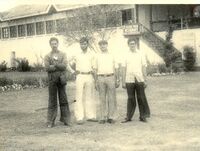
डल झील: श्रीनगर का सबसे बडा आकर्षण यहां की डल झील है। जहां सुबह से शाम तक रौनक नजर आती है। सैलानी घंटों इसके किनारे घूमते रहते हैं या शिकारे में बैठ नौका विहार का लुत्फउठाते हैं। दिन के हर प्रहर में इस झील की खूबसूरती का कोई अलग रंग दिखाई देता है। देखा जाए तो डल झील अपने आप में एक तैरते नगर के समान है। तैरते आवास यानी हाउसबोट, तैरते बाजार और तैरते वेजीटेबल गार्डन इसकी खासियत हैं। कई लोग तो डल झील के तैरते घरों यानी हाउसबोट में रहने का लुत्फलेने के लिए ही यहां आते हैं। झील के मध्य एक छोटे से टापू पर नेहरू पार्क है। वहां से भी झील का रूप कुछ अलग नजर आता है। दूर सडक के पास लगे सरपत के ऊंचे झाडों की कतार, उनके आगे चलता ऊंचा फव्वारा बडा मनोहारी मंजर प्रस्तुत करता है। झील के आसपास पैदल घूमना भी सुखद लगता है। शाम होने पर भी यह झील जीवंत नजर आती है। सूर्यास्त के समय आकाश का नारंगी रंग झील को अपने रंग में रंग लेता है, तो सूर्यास्त के बाद हाउसबोट की जगमगाती लाइटों का प्रतिबिंब झील के सौंदर्य को दुगना कर देता है। शाम के समय यहां खासी भीड नजर आती है।
भीड-भाड से परे शांत वातावरण में किसी हाउसबोट में रहने की इछा है तो पर्यटक नागिन लेक या झेलम नदी पर खडे हाउसबोट में ठहर सकते हैं। नागिन झील भी कश्मीर की सुंदर और छोटी-सी झील है। यहां प्राय: विदेशी सैलानी ठहरना पसंद करते हैं। उधर झेलम नदी में छोटे हाउसबोट होते हैं।
हाउसबोट का इतिहास: आज हाउसबोट एक तरह की लग्जरी में तब्दील हो चुके हैं और कुछ लोग दूर-दूर से केवल हाउसबोट में रहने का लुत्फउठाने के लिए ही कश्मीर आते हैं। हाउसबोट में ठहरना सचमुच अपने आपमें एक अनोखा अनुभव है भी। पर इसकी शुरुआत वास्तव में लग्जरी नहीं, बल्कि मजबूरी में हुई थी। कश्मीर में हाउसबोट का प्रचलन डोगरा राजाओं के काल में तब शुरू हुआ था, जब उन्होंने किसी बाहरी व्यक्ति द्वारा कश्मीर में स्थायी संपत्ति खरीदने और घर बनाने पर प्रतिबंध लगा दिया था। उस समय कई अंग्रेजों और अन्य लोगों ने बडी नाव पर लकडी के केबिन बना कर यहां रहना शुरू कर दिया। फिर तो डल झील, नागिन झील और झेलम पर हाउसबोट में रहने का चलन हो गया। बाद में स्थानीय लोग भी हाउसबोट में रहने लगे। आज भी झेलम नदी पर स्थानीय लोगों के हाउसबोट तैरते देखे जा सकते हैं। शुरुआती दौर में बने हाउसबोट बहुत छोटे होते थे, उनमें इतनी सुविधाएं भी नहीं थीं, लेकिन अब वे लग्जरी का रूप ले चुके हैं। सभी सुविधाओं से लैस आधुनिक हाउसबोट किसी छोटे होटल के समान हैं। डबल बेड वाले कमरे, अटैच बाथ, वॉर्डरोब, टीवी, डाइनिंग हॉल, खुली डैक आदि सब पानी पर खडे हाउसबोट में होता है। लकडी के बने हाउसबोट देखने में भी बेहद सुंदर लगते हैं। अपने आकार एवं सुविधाओं के आधार पर ये विभिन्न दर्जे के होते हैं। शहर के मध्य बहती झेलम नदी पर बने पुराने लकडी के पुल भी पर्यटकों के लिए एक आकर्षण है। कई मस्जिदें और अन्य भवन इस नदी के निकट ही स्थित है।
निशातबाग:निशात बाग़ भारत के केन्द्र शासित प्रदेश जम्मू और कश्मीर में श्रीनगर के निकट डल झील के पूर्व में स्थित सीढ़ीनुमा मुग़ल बाग़ है। यह कश्मीर घाटी का सबसे बड़ा मुग़ल बाग़ है। निशात बाग़ शब्द उर्दू भाषा का शब्द है जिसका हिन्दी अर्थ "हर्ष का उद्यान" अथवा "खुशियों का बगीचा" है। यह दश टेरेस में विभक्त है जो एक के ऊपर एक बनी दिखाई देती हैं। यह यहाँ की सबसे आकर्षक जगह है। ठीक बगीचे के बीचों-बीच एक जलधारा बहती है जिसमें अनेक फव्वारे लगे हैं। अनेक शैलानी यहाँ घूमने आते हैं तब इसकी शोभा और भी बढ़ जाती है। निशात बाग़ की परिकल्पना नूरजहाँ के बड़े भाई आसिफ खान द्वारा 1633 ई. ईरानी बगीचों की तर्ज पर तैयार की गई थी। निशातबाग में मुग़ल बादशाह आलमगीर II की पुत्री और बादशाह जहानदार शाह की पोती जूहरा बेगम को दफ़नाया गया है।
दाचीगम नेशनल पार्क (Dachigam National Park) - कश्मीरी भाषा में "दाचीगाम" का अर्थ "दशग्राम" है। यह नाम बहुत प्राचीन है। कल्हण की राजतरंगिनी[62] में दशग्राम का उल्लेख किया गया है। पाणिनि की अष्टाध्यायी (4.2.80.17) में दशग्राम का उल्लेख है। इस राष्ट्रीय उद्यान के क्षेत्र में दस गाँव हुआ करते थे, जिन्हें हटाकर यह संरक्षित क्षेत्र बनाया गया। पहाड़ों के बीच स्थित 141 वर्ग किमी एरिया, जिसमें से नदी बहती है, एक आदर्श अभ्यारण्य का नमूना है। इस क्षेत्र का चयन तत्कालीन महाराजा कश्मीर के द्वारा पीने के पानी के स्रोत के रूप में किया गया था। वर्ष 1931 में इसे 'रख' अर्थात गेम सेन्कचुरी घोषित किया गया। वर्ष 1951 में इसे सेन्कचुरी का दर्जा दिया गया। फ़रवरी 1981 में इसे नेशनल पार्क घोषित कर दिया है।
यह राष्ट्रीय उद्यान प्रसिद्ध डल झील के जलग्रहण क्षेत्र का लगभग आधे क्षेत्र पर अपना अधिकार रखता है और आज भी श्रीनगर के निवासियों को स्वच्छ पेयजल की आपूर्ति में महत्वपूर्ण भूमिका निभाता है। दाचीगाम राष्ट्रीय उद्यान पश्चिमी हिमालय की ज़बरवन पर्वतमाला में स्थित है। उद्यान उच्च ऊंचाई वाले शीतोष्ण क्षेत्र में स्थित है। इसकी ऊँचाई 5500 फुट से 14000 फुट तक की है। ऊँचाई में इतनी विविधता के कारण यहाँ हल्की ढलान वाली घासभूमियों से लेकर ऊँची चट्टाने व पहाड़ हैं। उद्यान में पाए जाने वाले मुख्य पेड़ हैं – हिमालयी नम शीतोष्ण सदाबहार, नम पर्णपाती और झाड़ियां, देवदार, चीड़ एवं शाहबलूत (ओक)।
दाचीगाम विशेष रूप से कश्मीरी हंगुल (हिरण) के लिए प्रसिद्ध है। इसके अलावा यहाँ कस्तूरी मृग, हिम तेन्दुआ, हिमालय सराव, कश्मीर धूसर लंगूर, चीता बिल्ली, हिमालयी काला भालू, हिमालय भूरा भालू, गीदड़, पहाड़ी लोमड़ी, हिमालय रासू, जंगली बिल्ली और ऊदबिलाव मिलते हैं। वसंत और शरद ऋतु में नीचले इलाकों में हिमालयी काला भालू दिखाई देता है। सर्दी के मौसम में यह सो जाता है। लंबी पूंछ वाले मार्मोट गर्मी के मौसम में उपरी इलाकों में बहुत देखे जा सकते हैं जबकि चूहे के जैसे खरहे (Mouse Hare) पूरे वर्ष सक्रिए रहते हैं। पक्षियों में तीतर के कोकलास और मोनल, बुलबुल, मिनिवेट, बार्ड वल्चर, सुनहरे चील आम हैं।
शालीमार बाग़ : शालीमार बाग़ भारत के जम्मू और कश्मीर राज्य में विख्यात उद्यान है जो मुगल बाग का एक उदाहरण है। इसे मुगल बादशाह जहाँगीर ने श्रीनगर में बनवाया था। श्रीनगर भारत के उत्तरतम राज्य जम्मू एवं कश्मीर की ग्रीष्म-कालीन राजधानी है। इसे जहाँगीर ने अपनी प्रिय एवं बुद्धिमती पत्नी मेहरुन्निसा के लिये बनवाया था, जिसे नूरजहाँ की उपाधि दी गई थी। इस बाग में चार स्तर पर उद्यान बने हैं एवं जलधारा बहती है। इसकी जलापूर्ति निकटवर्ती हरिवन बाग से होती है।[63] उच्चतम स्तर पर उद्यान, जो कि निचले स्तर से दिखाई नहीं देता है, वह हरम की महिलाओं हेतु बना था।[64] यह उद्यान ग्रीष्म एवं पतझड़ में सर्वोत्तम कहलाता है। इस ऋतु में पत्तों का रंग बदलता है एवं अनेकों फूल खिलते हैं। यही उद्यान अन्य बागों की प्रेरणा बना, खासकर इसी नाम से लाहौर, पाकिस्तान में निर्मित और विकसित बाग की। यह वर्तमान में एक सार्वजनिक बाग़ है। यह उन सबसे बड़े उद्द्यानों में से है जो फव्वारों और विभिन्न प्रकार के प्रकाश से सुसज्जित है। इसको देख कर मुग़ल बादशाह जहांगीर और नूरजहां के प्यार की याद ताजा हो जाती है। इस उद्द्यान को बादशाह जहांगीर ने 1619 में बनवाया था। इसके पूर्ण निर्माण होने पर जहाँगीर ने फारसी की वह प्रसिद्ध अभिव्यक्ति कही थी :“ यदि पृथ्वी पर कहीं स्वर्ग है, तो वह यहीं है, यहीं है, यहीं है। यहाँ फ़ारसी भाषा में जहांगीर का शिलालेख भी लगा है - 'गर फिरदौस रॉय-ए जमीन अस्त, हमीन अस्त-ओ हमीन अस्त-ओ हमीन अस्त'। मुग़ल रोमांस पर इसमें शाम को 8 बजे ध्वनि और प्रकाश कार्यक्रम दिखाया जाता है।
चश्मा ए शाही:
चश्मा ए शाही जम्मू और कश्मीर राज्य के श्रीनगर शहर में स्थित एक बाग़ है। श्रीनगर के मुग़ल बाग़ों में यह सबसे छोटा बाग़ है। चश्मा शाही नेहरू मेमोरियल पार्क के ऊपर स्थित है। इसे शाहजहां के गवर्नर अली मरदान खान ने 1632 ई. में दारा शिकोह को उपहार स्वरूप बनाया बनाया था। चश्मा शाही के पूर्व में परी महल स्थित है जहाँ दारा शिकोह खगोल-विज्ञान सीखते थे और वहीं बाद में औरंजेब ने दारा शिकोह की हत्या कर दी थी।
चश्मा शाही बाग़ यहाँ से झरने के रूप में फूटने वाले अपने सुपाच्य मिनरल वाटर के लिये प्रख्यात है। चश्मा शाही डल झील तथा आसपास की पहाड़ियों का अत्यन्त सुन्दर, मनमोहक और रम्य दृश्य प्रस्तुत करता है। यह बहुत ही सुन्दर बगीचा पहाड़ी के ठीक नीचे बना हुआ है। यहाँ बहुत शांत वातावरण है। एक झरने का ठंडा पानी बहता है जो स्वास्थ्य के लिए बहुत लाभदायक बताया जाता है। चारों तरफ गुलाब के अनेक रंगों के फूल हैं जहाँ प्रेमी लोग अलग से अपना कोना ढूंढ लेते हैं और अन्य पर्यटक लोगों का दिल जलाते हैं। कोई प्रेमी अपनी प्रेमिका के लिए फूल तोड़ कर उसके जूड़े में सजा रहा है तो कोई प्रेमी अपनी प्रेमिका का विभिन्न पोज में फ़ोटो लेने में मस्त है। कुछ जोड़े तो यहाँ इतने सुन्दर हैं कि लोग उनको दूर तक मन्त्र-मुग्ध होकर देखते जाते हैं। शायद इसीलिए इस बगीचे को 'गार्डन ऑफ़ लव' कहा जाता है।
हरि पर्वत, श्रीनगर
हरि पर्वत जम्मू-कश्मीर की राजधानी श्रीनगर में डल झील के पश्चिम ओर स्थित है। इस छोटी पहाड़ी के शिखर पर इसी नाम का एक किला बना है जिसका अनुरक्षण जम्मू कश्मीर सरकार के पुरातत्व विभाग के अधीन है। इस किले में भ्रमण हेतु पर्यटकों को पहले पुरातत्त्व विभाग से अनुमति लेनी होती है। क़िले का निर्माण एक अफ़ग़ान गर्वनर मुहम्मद ख़ान ने 18वीं शताब्दी में करवाया था। उसके बाद 1590 ई. में मुग़ल सम्राट अकबर द्वारा इस क़िले की चहारदीवारी का निर्माण करवाया गया।[65]
पौराणिक सन्दर्भ: एक पौराणिक कथा के अनुसार, पौराणिक काल में यहां एक बड़ी झील हुआ करती थी, जिस पर जालोभाव नामक दैत्य का अधिकार था जो लोगों को खूब सताता था। तब लोगों ने भगवान शिव की अर्धांगिनी एवं कश्मीर की अधिष्ठात्री देवी माता सती से सहायता की प्रार्थना की। तब सती माता एक चिड़िया का रूप (शारिका) धारण करके प्रकट हुईं एवं उस राक्षस के सिर पर एक छोटा सा पत्थर रख दिया जो धीरे-धीरे आकार में बढ़ता गया और राक्षस का सिर कुचल गया। हरी पर्वत पर एक बड़ा मन्दिर है जिसे शारिका देवी मन्दिर कहते हैं। यहाँ पार्वती की शारिका के रूप में पूजा की जाती है।
इसी पर्वत पर एक गुरुद्वारा भी स्थित है। इसे छट्टी पादशाही का गुरुद्वारा भी कहते हैं जो रैनावाड़ी में स्थित है। कहते हैं छठे सिख गुरु हरगोबिन्द सिंह यहां पधारे थे।
हज़रतबल:
हज़रतबल (Hazratbal) भारत के जम्मू व कश्मीर राज्य के श्रीनगर शहर में स्थित एक प्रसिद्ध दरगाह है। मान्यता है कि इसमें इस्लाम के नबी, पैग़म्बर मुहम्मद, का एक दाढ़ी का बाल रखा हुआ है, जिस से लाखों लोगों की आस्थाएँ जुड़ी हुई हैं। कश्मीरी भाषा में 'बल' का अर्थ 'जगह' होता है, और हज़रतबल का अर्थ है 'हज़रत (मुहम्मद) की जगह'। हज़रतबल डल झील की बाई ओर स्थित है और इसे कश्मीर का सबसे पवित्र मुस्लिम तीर्थ माना जाता है। फ़ारसी भाषा में 'बाल' को 'मू' या 'मो' कहा जाता है, इसलिए हज़रतबल में सुरक्षित बाल को 'मो-ए-मुक़द्दस' या 'मो-ए-मुबारक' (पवित्र बाल) भी कहा जाता है।
हज़रतबल को लेकर यह मान्यता है कि पैग़म्बर मुहम्मद के वंशज सय्यद अब्दुल्लाह सन् 1635 में मदीना से चलकर भारत आये और आधुनिक कर्नाटक राज्य के बीजापुर क्षेत्र में आ बसे। अपने साथ वह इस पवित्र केश को भी लेकर आये। जब सय्यद अब्दुल्लाह का स्वर्गवास हुआ तो उनके पुत्र, सय्यद हामिद, को यह पवित्र केश विरासत में मिला। उसी काल में मुग़ल साम्राज्य का उस क्षेत्र पर क़ब्ज़ा हो गया और सय्यद हामिद की ज़मीन-सम्पत्ति छीन ली गई। मजबूर होकर उन्हें यह पवित्र-वस्तु एक धनवान कश्मीरी व्यापारी, ख़्वाजा नूरुद्दीन एशाई को बेचनी पड़ी। व्यापारी द्वारा इस लेनदेन के पूरा होते ही इसकी भनक मुग़ल सम्राट औरंगज़ेब तक पहुँच गई, जिसपर यह बाल नूरुद्दीन एशाई से छीनकर अजमेर शरीफ़ में मोइनुद्दीन चिश्ती की दरगाह पर भेज दिया गया और व्यपारी को बंदी बना लिया गया। कुछ अरसे बाद औरंगज़ेब का मन बदल गया और उसने बाल नूरुद्दीन एशाई को वापस करवाया और उसे कशमीर ले जाने की अनुमति दे दी। लेकिन तब तक बहुत देर हो चुकी थी और नूरुद्दीन एशाई ने कारावास में ही दम तोड़ दिया था। पवित्र बाल उनके शव के साथ सन् 1700 में कश्मीर ले जाया गया जहाँ उनकी पुत्री, इनायत बेगम, ने पवित्र वस्तु के लिये दरगाह बनवाई। इनायत बेगम का विवाह श्रीनगर की बान्डे परिवार में हुआ था इसलिये तब से इसी बान्डे परिवार के वंशज इस पवित्र केश की निगरानी के लिये ज़िम्मेदार हो गये।[66]
शिरिनेत = सिरनेत
शिरिनेत = सिरनेत (AS, p.900) = गढ़वाल अथवा श्रीनगर का निकटवर्ती प्रदेश. शायद शिरिनेत अथवा सिरनेत श्रीनगर का ही अपभ्रंस है. [67]
काश्यप लोग
ठाकुर देशराज[68] ने लिखा है.... काश्यप - शिवि लोगों के वर्णन में मिस्टर क्रूक साहब के हवाले से यह बात हम बता चुके हैं कि जाटों में एक बड़ा समूह काश्यप लोगों का भी है। सूर्यवंश की प्रसिद्धि इन्हीं काश्यप से बताई जाती है। काशी के काश्य भी काश्यप हैं जो कि जाटों के अंदर काफी काशीवात कहलाते हैं। मगध के लिच्छवि शाक्य और ज्ञातृ भी काश्यप ही थे। इनके अलावा सैकड़ों काश्यिप गोत्री खानदान जाटों में मौजूद हैं। पुराणों में तो कैस्पियन सागर को कश्यप ऋषि का आश्रम बताया है। कुछ लोग श्रीनगर से 3 मील दूर हरी पर्वत पर कश्यप ऋषि का आश्रम मानते हैं।
Kasmir visit of Xuanzang in 631 AD
Alexander Cunningham[69] writes that Srinagari, the old capital of Kashmir prior to the erection of Pravarasenapura, is stated to have been founded by the great Asoka, [70] who reigned from B.C. 263 to 226. It stood on the site of the present Pandrethan, and is said to have extended along the bank of the river from the foot of the Takht-i-Suliman to Pantasok, a distance of more than three miles. The oldest temple in Kashmir, on the top of the Takht-i-Suliman, is identified by the unanimous consent of all the Brahmans of the valley with the temple of Jyeshta Rudra, which was built by Jaloka, the son of Asoka, in Srinagari.[71] This identification is based on the fact that the hill was originally called Jyeshteswara. The old bridge abutments at the village of Pantasok are
[p.96]: also attributed to Asoka ; and the other ruins at the same place are said to be the remains of the two Asokeswara temples which are noted in the native chronicle of Kashmir. Srinagari was still the capital of the valley in the reign of Pravarasena I., towards the end of the fifth century, when the King erected a famous symbol of the god Siva, named after himself Pravareswara. This city still existed in A.D. 631, when the Chinese pilgrim Xuanzang arrived in Kashmir, although it was no longer the capital of the valley. Xuanzang speaks of the capital of his time as the " new city," and states that the " old city " was situated to the south-east of it, at a distance of ten li, or nearly two miles, and to the south of a high mountain. This account describes the relative positions of Pandrethan and the present capital with the lofty hill of Takht-i-Suliman so exactly, that there can be no hesitation in accepting them as the representatives of the ancient places. The old city was still inhabited between A.D. 913 and 921, when Meru, the minister of Raja Partha, erected in Puranadhisthana, that is in the " old capital," a temple named after himself Meru-Varddhana-swami. This building I have identified with the existing temple of Pandrethan, as Kalhan Pandit relates[72] that, when Raja Abhimanyu set fire to his capital, all the noble buildings "from the temple of Varddhana Swami, as far as Bhikshukiparaka, (or the asylum of mendicants) were destroyed. I attribute the escape of the limestone temple to its fortunate situation in the midst of a tank of water. To this catastrophe I would assign the final desertion of the old capital, as the humble dwellings of the people could not possibly have escaped the destructive
[p.97]: fire which consumed all the " noble edifices " of the city.
Pravarasenapura, or the new capital, was built by Raja Pravarasena II. in the beginning of the sixth century. Its site, as already noted, was that of the present capital of Srinagar. This is determined beyond all possibility of doubt by the very clear and distinct data furnished by the Chinese pilgrim Hwen Thsang, and by the Hindu historian Kalhan Pandit. The statements of the first have already been quoted in my account of the old capital ; but I may add that Hwen Thsang resided for two whole years in Kashmir, in the Jayendra Vihara[73] or Buddhist monastery, built by Jayendra, the maternal uncle of Pravarasena. The Hindu author describes the city as situated at the confluence of two rivers, and with a hill in the midst of it. This is an exact description of the present Srinagar, in the midst of which stands the hill of Hari Parbat, and through which flows the river Hara, or Ara, to join the Behat at the northern end of the city.[74]
References
- ↑ Hyun Jin Kim's Book, "The Huns" (2015) publisher-'Routledge'
- ↑ 1. Lawrence, Sir Walter Roper (2005). The Valley of Kashmir. Asian Educational Services. p. 35. ISBN 978-81-206-1630-1; 2. M. Monier Monier–Williams, "Śrīnagar", in: The Great Sanskrit–English Dictionary, Oxford University Press, Oxford, 1899
- ↑ Rajatarangini of Kalhana:Kings of Kashmira/Book I,p.8
- ↑ kashmir-tours.net
- ↑ Rajatarangini of Kalhana:Kings of Kashmira/Book III,p.52-53
- ↑ Rajatarangini of Kalhana:Kings of Kashmira/Book I,p.8
- ↑ Sreedharan, E. (2004), A Textbook of Historiography: 500 BC to AD 2000, Orient Blackswan, ISBN 978-81-250-2657-0
- ↑ Srinagar.nic.in, Official website of the city and district.
- ↑ Chatterjee, Suhas (1998), Indian Civilization And Culture, M.D. Publications, ISBN 978-81-7533-083-2
- ↑ Singh, Upinder (2008), A History of Ancient and Early Medieval India: From the Stone Age to the 12th Century, Pearson Education India, ISBN 978-81-317-1120-0
- ↑ Rajatarangini of Kalhana:Kings of Kashmira/Book IV,p. 61
- ↑ Lawrence, Walter R (1985) [1895]. Valley Of Kashmir. Oxford University Press Warehouse. p. 35. Retrieved 2012-03-14.
- ↑ "Profile of Srinagar". Indian Heritages Cities Network.
- ↑ Holloway, James (13 June 1965). "Fabled Kashmir: An Emerald Set Among Pearls". Pqasb.pqarchiver.com.
- ↑ http://www.discoveredindia.com/jammu-and-kashmir/attractions/parks-and-gardens/jawaharlal-nehru-memorial-botanical-garden.htm
- ↑ https://srinagar.nic.in/places-of-interest/
- ↑ http://jktdc.in/contact-us/99.html
- ↑ http://jktdc.in/contact-us/99.html
- ↑ http://jktdc.in/contact-us/99.html
- ↑ http://jktdc.in/contact-us/99.html
- ↑ http://jktdc.in/contact-us/99.html
- ↑ http://jktdc.in/contact-us/99.html
- ↑ https://www.cntraveller.in/story/trail-kashmirs-shrines/
- ↑ Cunningham, Alexander (1848). An Essay on the Arian Order of Architecture, as Exhibited in the Temples of Kashmir. Calcutta: J. Thomas, Baptist Mission Press.
- ↑ Stein, Aurel (1900). Kalhana's Rajatarangini, A Chronicle of the Kings of Kashmir. Vol. 2. Westminster: Archibald Constable and Company, Rivington. pp. 453–454
- ↑ Warikoo, Kulbhushan (2009). Toshkhani, S. S.; Warikoo, K. (eds.). Cultural Heritage of Kashmiri Pandits. Pentagon Press. pp. 109–110. ISBN 978-81-8274-398-4.
- ↑ Fergusson, James (1899). History of Indian and Eastern Architecture. Vol. 1. Dodd, Mead. p. 282.
- ↑ Stein, Aurel (1900). Kalhana's Rajatarangini, A Chronicle of the Kings of Kashmir. Vol. 1. Archibald Constable and Company, Rivington. p. 1.345
- ↑ Cunningham, Alexander (1848). An Essay on the Arian Order of Architecture, as Exhibited in the Temples of Kashmir. Calcutta: J. Thomas, Baptist Mission Press. p.7
- ↑ Thapar, Romila (1961). Aśoka and the Decline of the Mauryas. Oxford University Press. pp. 30, 188.
- ↑ Stein, Aurel (1900). Kalhana's Rajatarangini, A Chronicle of the Kings of Kashmir. Vol. 2. Westminster: Archibald Constable and Company, Rivington. pp. 453–454
- ↑ Cunningham, Alexander (1848). An Essay on the Arian Order of Architecture, as Exhibited in the Temples of Kashmir. Calcutta: J. Thomas, Baptist Mission Press,p.9
- ↑ 1. "Shalimar Gardens in Srinagar". Archnet.org. Archived from the original on 18 August 2010. 2. Bindloss, Joe; Sarina Singh (2007). India. Srinagar. Lonely Planet. pp. 353–354, 360. ISBN 1-74104-308-5. "Dal Lake."
- ↑ Bindloss, Joe; Sarina Singh (2007). India. Srinagar. Lonely Planet. pp. 353–354, 360. ISBN 1-74104-308-5. "Dal Lake."
- ↑ Stuart, C.M. Villiers (2008). Gardens of the Great Mughals (1913). Gardens of Dal Lake: Nishat Bagh. READ BOOKS. pp. 168–169, 171. ISBN 1-4097-1962-6.
- ↑ Bindloss, Joe; Sarina Singh (2007). India. Srinagar. Lonely Planet. pp. 353–354, 360. ISBN 978-1-74104-308-2. Retrieved 29 December 2009. "Dal Lake."
- ↑ "Shalimar Gardens in Srinagar". Archnet.org.
- ↑ "Govt. Website".
- ↑ Stuart, C.M. Villiers (2008). Gardens of the Great Mughals (1913). Gardens of Dal Lake. Read Books. pp. 162–166. ISBN 978-1-4097-1962-5.
- ↑ "Shalimar Gardens in Srinagar". Archnet.org.
- ↑ "Shalimar Bagh Mughal Garden, Srinagar".
- ↑ "The Royal Gardners of Mughal India".
- ↑ Charles W. Moore, William J. Mitchell, William Turnbull (1993). The Poetics of Gardens. MIT Press, 1993. p. -167. ISBN 978-0-262-63153-2.
- ↑ "Srinagar attractions". nativeplanet.
- ↑ Charles W. Moore, William J. Mitchell, William Turnbull (1993). The Poetics of Gardens. MIT Press, 1993. p. -167. ISBN 978-0-262-63153-2.
- ↑ Parmanand Parashar (2004). Kashmir The Paradise Of Asia. Sarup & Sons, 2004. p. -230. ISBN 978-81-7625-518-9.
- ↑ "Attractions in Srinagar". journeymart.
- ↑ Sumita Roy, Annie Pothen, K. S. Sunita (2003). Amit Kumar And Indian Thought. terling Publishers Pvt. Ltd, 2003. p. -56. ISBN 978-81-207-2465-5.
- ↑ Shakeel Ahmed, Ramaswamy Jayakumar, Abdin Salih (2008). Groundwater Dynamics in Hard Rock Aquifers: Sustainable Management and Optimal Monitoring Network Design. Springer, 2008. p. -246. ISBN 978-1-4020-6539-2.
- ↑ 1. Asher, Catherine .B (1992). Architecture of Mughal India. Vol. 4. Cambridge University Press. p. 124. ISBN 9780521267281. "In Kashmir's capital city , Srinagar , Akbar had constructed a massive fort on a high hill known as the Koh - i Maran or Hari Parbat overlooking Dal lake ." 2. Kashir Encyclopedia (in Kashmiri). Vol. 1. Jammu and Kashmir Academy of Arts Culture and Languages. 1986. p. 403.
- ↑ "India at 75: 100-feet tall national flag hoisted at Hari Parbat Fort in Srinagar - Hari Parbat"
- ↑ Nilamata Purana.
- ↑ Excelsior, Daily (14 June 2014). "Hariparbat-The abode of Goddess Sharika"
- ↑ Hamza Makhdum
- ↑ Asher, Catherine B. (24 September 1992). Architecture of Mughal India. Cambridge University Press. p. 215. doi:10.1017/chol9780521267281. ISBN 978-0-521-26728-1.
- ↑ "Gurudwara Patshahi Chevin, Village Rainawari". AllAboutSikhs.com.
- ↑ "Gurdwara Guru Nanak Dev Ji, Hari Parbat, Sri Nagar". www.sikhphilosophy.net. Sikh Philosophy Network.
- ↑ भारतकोश - शंकराचार्य मंदिर श्रीनगर
- ↑ Rajatarangini of Kalhana:Kings of Kashmira/Book II,p.33
- ↑ Laxman Burdak (talk) 07:22, 6 May 2022 (UTC)
- ↑ Aitihasik Sthanavali by Vijayendra Kumar Mathur, p.919
- ↑ Kings of Kashmira Vol 2 (Rajatarangini of Kalhana)/Book VIII (ii) p.269,270.
- ↑ http://jammukashmir.nic.in/tourism/kashmir/shalimar.htm
- ↑ http://www.kashmir-tourism.net/jammu-kashmir/kashmir-gardens.html
- ↑ भारतकोश- हरिपर्वत क़िला श्रीनगर
- ↑ Kashmir: Jammu, Kashmir Valley, Ladakh, Zanskar, Max Lovell-Hoare, Sophie Lovell-Hoare, P. 206, Published by Lonely Planet, 2014.
- ↑ Aitihasik Sthanavali by Vijayendra Kumar Mathur, p.900
- ↑ Jat Itihas (Utpatti Aur Gaurav Khand)/Pancham Parichhed,p.99
- ↑ The Ancient Geography of India/Kingdom of Kashmir,pp.95-97
- ↑ 'Raja Tarangini,' i. 104.
- ↑ ' Raja Tarangini,' i. 124.
- ↑ See my ' Temples of Kashmir,' p. 41; and ' Raja Tarangini.'.vi. 191.
- ↑ ' Hiouen Thsang,' i. 96.
- ↑ 'Moorcroft's Travels,' ii. 276. I speak also from personal knowledge, as I have twice visited Kashmir.
